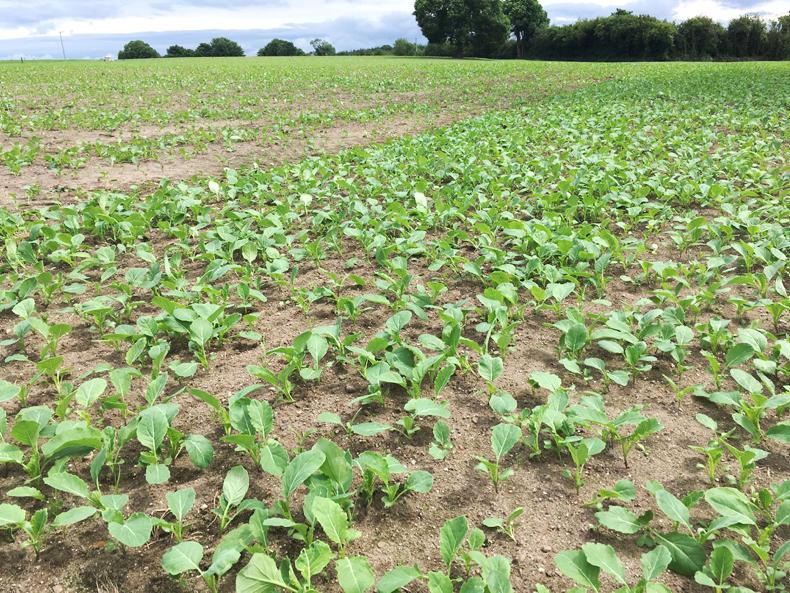Growing a kale crop can provide a boost to fodder reserves on some farms. It can be high-yielding and is sown in May/June and grazed from October until March.
The yield varies depending on growing site and weather, but generally ranges from 8-10t/DM/Ha.
Growing kale will reduce feed costs, and the labour associated labour can be reduced by setting up the grazing system so that the fence only needs to be moved once per day.
Benefits
There are a number of benefits to animals from grazing kale.
As the animals are outside, they are accustomed to the weather conditions and can adapt quickly to grass in spring.
Animals also tend to put on frame rather than condition, meaning they will thrive very quickly when put to grass.
In-calf suckler cows are also much fitter as they are constantly on the move and calve easier as a result. Animal performance from beef bulls in Grange and dairy heifers in Moorepark have seen weight gains of 0.7kg/day on a kale diet.
No added labour
Kale does require extra labour during the winter, moving fences and checking stock daily.
You also need good fences and a strong electric current to make sure it is grazed properly.
It’s a good idea to place a line of bales of silage in the field at sowing time and then feeders can be moved with a fence at feeding time in winter.
This means there is no need to bring a tractor into the field in winter, reducing the risk of rutting.
Access
Animals also need access to 1ha of lie-back area in order to meet cross-compliance requirements.
The sowing rate depends on the sowing method – if sowing via the broadcast method, sow 2kg/ac to 3kg/ac and if direct-drilling sow at 1.5kg/ac to 2kg/ac. Kale requires high fertility levels and optimum pH is 6 to 6.7.
You will need to spread four bags/acre of 10:10:20 at sowing time and topdress with two bags CAN/acre after emergence.

Tullamore farm
Ten acres of kale were sown on Tullamore Farm on 10 June 2017. The field was ploughed and kale was sown with a one-pass.
The sowing rate was 2.2kg/acre and the variety sown was Maris Kestrel.
The pH of the land in Tullamore is high at 6.9, so no lime was required.
We spread four bags per acre of 10:10:20 at sowing and topdressed with two bags per acre of CAN on 5 July.
The plan is to graze the kale with April-calving suckler cows over the winter, commencing in early-November.
Read more
Farm to farm feed: what are the options?
Grass varieties impact on methane emissions
Reseeding checklist: eight tips for a good job
Full coverage of the 2017 reseeding focus
Growing a kale crop can provide a boost to fodder reserves on some farms. It can be high-yielding and is sown in May/June and grazed from October until March.
The yield varies depending on growing site and weather, but generally ranges from 8-10t/DM/Ha.
Growing kale will reduce feed costs, and the labour associated labour can be reduced by setting up the grazing system so that the fence only needs to be moved once per day.
Benefits
There are a number of benefits to animals from grazing kale.
As the animals are outside, they are accustomed to the weather conditions and can adapt quickly to grass in spring.
Animals also tend to put on frame rather than condition, meaning they will thrive very quickly when put to grass.
In-calf suckler cows are also much fitter as they are constantly on the move and calve easier as a result. Animal performance from beef bulls in Grange and dairy heifers in Moorepark have seen weight gains of 0.7kg/day on a kale diet.
No added labour
Kale does require extra labour during the winter, moving fences and checking stock daily.
You also need good fences and a strong electric current to make sure it is grazed properly.
It’s a good idea to place a line of bales of silage in the field at sowing time and then feeders can be moved with a fence at feeding time in winter.
This means there is no need to bring a tractor into the field in winter, reducing the risk of rutting.
Access
Animals also need access to 1ha of lie-back area in order to meet cross-compliance requirements.
The sowing rate depends on the sowing method – if sowing via the broadcast method, sow 2kg/ac to 3kg/ac and if direct-drilling sow at 1.5kg/ac to 2kg/ac. Kale requires high fertility levels and optimum pH is 6 to 6.7.
You will need to spread four bags/acre of 10:10:20 at sowing time and topdress with two bags CAN/acre after emergence.

Tullamore farm
Ten acres of kale were sown on Tullamore Farm on 10 June 2017. The field was ploughed and kale was sown with a one-pass.
The sowing rate was 2.2kg/acre and the variety sown was Maris Kestrel.
The pH of the land in Tullamore is high at 6.9, so no lime was required.
We spread four bags per acre of 10:10:20 at sowing and topdressed with two bags per acre of CAN on 5 July.
The plan is to graze the kale with April-calving suckler cows over the winter, commencing in early-November.
Read more
Farm to farm feed: what are the options?
Grass varieties impact on methane emissions
Reseeding checklist: eight tips for a good job
Full coverage of the 2017 reseeding focus







 This is a subscriber-only article
This is a subscriber-only article










SHARING OPTIONS: